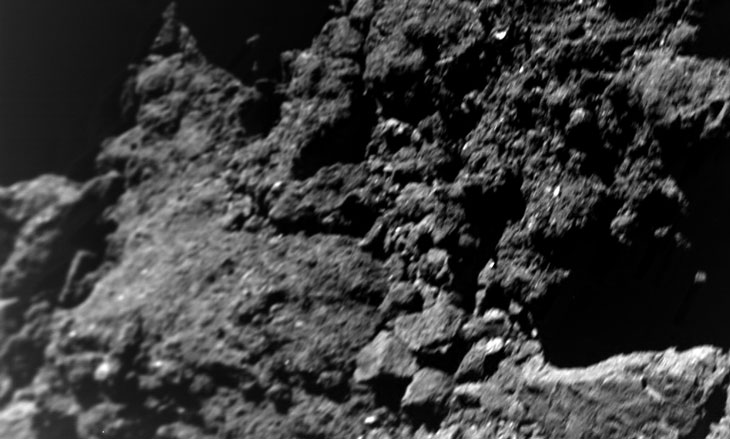 |
| A picture from MASCOT lander |
Ryugu is a neat freak. The surface of the small, near-Earth asteroid is surprisingly free of dust, observations from Gremany's MASCOT lander show. The asteroid, thought to have formed from the breakup of a larger body around 700 million years ago, has no atmosphere to protect it from interplanetary dust streaming through the solar system. These miniature missiles pummel exposed space rocks at high speed, breaking down their surfaces into thin layers of dust and dirt, such as those found on the moon and the asteroid Vesta.
Ryugu could hide its dust in larger, porous rockes or deep in its interios, Jaumann and colleagues say. Shaking due to a meteorite impact may shuffle the particles into bigger surface rocks or down through small surface cracks to to asteroid's center and out of sight, the way small nuts end up at the bottom of a cup of trail mix.
Ryugu could hide its dust in larger, porous rockes or deep in its interios, Jaumann and colleagues say. Shaking due to a meteorite impact may shuffle the particles into bigger surface rocks or down through small surface cracks to to asteroid's center and out of sight, the way small nuts end up at the bottom of a cup of trail mix.
Ryugu could hide its dust in larger, porous rockes or deep in its interios, Jaumann and colleagues say. Shaking due to a meteorite impact may shuffle the particles into bigger surface rocks or down through small surface cracks to to asteroid's center and out of sight, the way small nuts end up at the bottom of a cup of trail mix.
Ryugu could hide its dust in larger, porous rockes or deep in its interios, Jaumann and colleagues say. Shaking due to a meteorite impact may shuffle the particles into bigger surface rocks or down through small surface cracks to to asteroid's center and out of sight, the way small nuts end up at the bottom of a cup of trail mix.
Ryugu could hide its dust in larger, porous rockes or deep in its interios, Jaumann and colleagues say. Shaking due to a meteorite impact may shuffle the particles into bigger surface rocks or down through small surface cracks to to asteroid's center and out of sight, the way small nuts end up at the bottom of a cup of trail mix.Ryugu could hide its dust in larger, porous rockes or deep in its interios, Jaumann and colleagues say. Shaking due to a meteorite impact may shuffle the particles into bigger surface rocks or down through small surface cracks to to asteroid's center and out of sight, the way small nuts end up at the bottom of a cup of trail mix.Ryugu could hide its dust in larger, porous rockes or deep in its interios, Jaumann and colleagues say. Shaking due to a meteorite impact may shuffle the particles into bigger surface rocks or down through small surface cracks to to asteroid's center and out of sight, the way small nuts end up at the bottom of a cup of trail mix.
Ryugu could hide its dust in larger, porous rockes or deep in its interios, Jaumann and colleagues say. Shaking due to a meteorite impact may shuffle the particles into bigger surface rocks or down through small surface cracks to to asteroid's center and out of sight, the way small nuts end up at the bottom of a cup of trail mix.



0 Comments